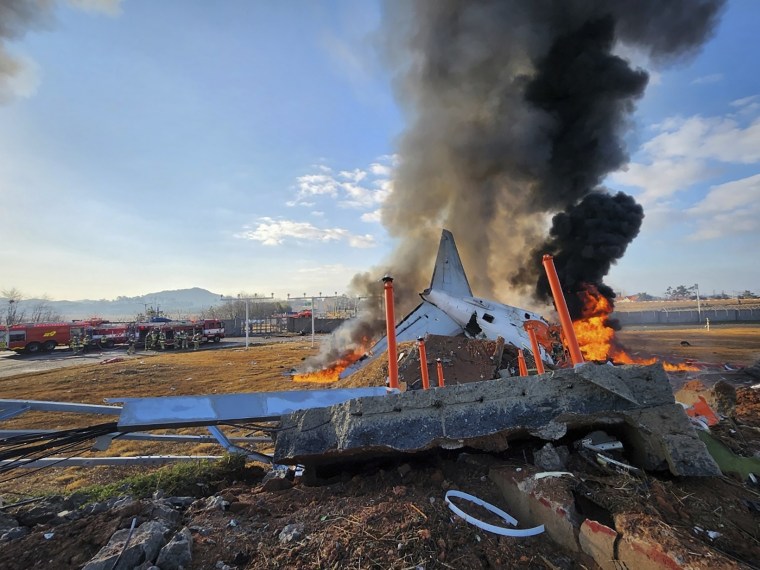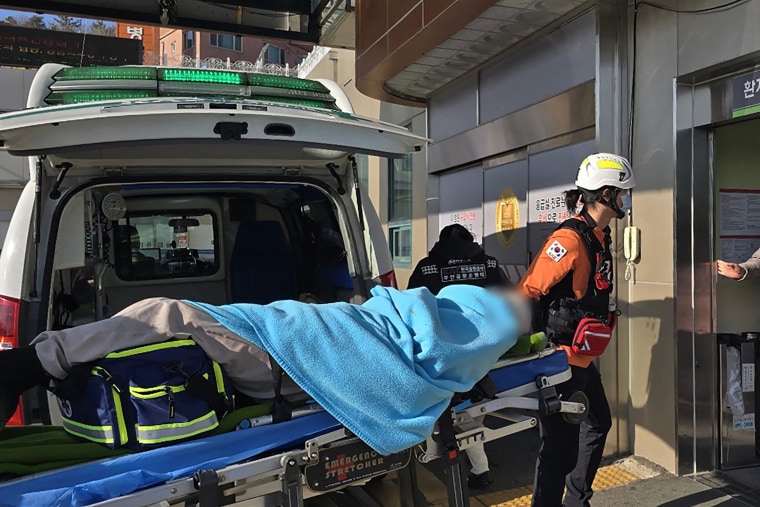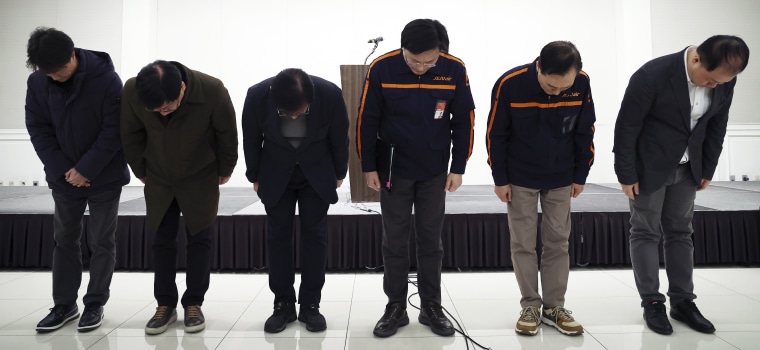SEOUL, South Korea — Two people survived and 179 were confirmed to have been killed in a plane crash at a South Korean airport Sunday. There were 181 passengers and crew on board.
The Jeju Air Flight 2216 skidded off the runway while it was landing at Muan International Airport and burst into flames after it crashed, a spokesperson for the country’s National Fire Agency said.
The airport is about 180 miles south of Seoul.
The Boeing 737-800 plane took off from Bangkok shortly after 2 a.m. local time (2 p.m. Saturday ET), according to the flight-tracking platform FlightAware. It was carrying 175 passengers and six crew members, said Joo Jong-wan, director of the Aviation Policy Division at South Korea’s Ministry of Land, Infrastructure and Transport.
At least two of the passengers were Thai, Joo said. Most of the rest are believed to be Korean.
“The pilot declared mayday after issuing the bird strike alert,” Joo said, adding that the aircraft was “completely destroyed.”
The plane skidded along the runway and exploded as it rammed into a barrier, a video verified by NBC News showed. The tail was the only part that appeared to remain intact as flames engulfed the aircraft, sending a plume of black smoke into the air.
Deadliest airline disaster of the year
The national fire agency confirmed the deaths of 179 people, making it the deadliest airline disaster of the year and what appears to be the first fatal accident since the low-cost airline was founded in 2005.

The Ministry of Land, Infrastructure, and Transport said 146 bodies had been identified as of 3 p.m. Monday local time.
As the confirmed death toll ticked up, anxious families gathered at the airport, awaiting news of their loved ones. An announcer carefully read out the names of those confirmed dead.
Screams and cries erupted from family members as the identities were confirmed according to reports by the South Korean news agency Newsis. The Red Cross set up tents to provide privacy for grieving family members.
Families of victims formed a group led by Park Han-shin, who lost his brother in the crash. During a briefing Monday, Park said Jeju Air must fully pay for funeral services and that a memorial altar should be set up inside the airport, on the first floor.
At least 84 of the dead were women and 82 were men. The genders of 11 other victims were not immediately identifiable.
Several children died in the crash, including four elementary school students, three middle school students and four high school students, Ministry of Education spokesperson Gu Yeon-hee said in a briefing Monday.
One of the victims was a preschool child born in 2021, Gu said.
Two crew members — a man and a woman — were rescued; they sustained moderate injuries but were conscious, Joo said.
South Korea's Yonhap news agency reported that one of them, a 33-year-old flight attendant identified with his surname, Lee, sustained multiple injuries, including fractured ribs and traumatic spinal injuries, according to Ju Woong, director of Ewha Woman's University Seoul Hospital, where Lee was transferred.
“When I woke up, I had already been rescued,” Ju said Lee told the doctors, adding that he was in intensive care but was able to communicate well. "There’s no indication yet of memory loss or such,” Ju said.

The other survivor, a 25-year-old woman with the surname Koo, was taken to Asan Medical Center in Seoul. Koo reportedly sustained injuries to her ankle and head and was stable.
A bird strike likely set off the disaster
Joo, the aviation official, gave an outline of the sequence of events leading to the disaster.
The pilots initially tried to land on the airport’s Runway 1, he said, but control tower instructed them to land on the opposite side, Runway 19, because of a bird strike warning. A bird strike is a collision between a bird and an aircraft.
A minute later, the pilots sent a mayday signal following a bird strike and tried to land on Runway 19.
As it was passing over the runway, the plane failed to lower its landing gear and struck a safety system called a localizer — which provides guidance during landing — and it crashed into a wall, Joo said.
The crash happened at around 9:03 a.m. local time (7:03 p.m. ET Saturday), and firefighters put out the initial blaze at 9:46 a.m. local time, the fire agency spokesperson said.
The plane was “completely destroyed by fire,” Joo said at a briefing, adding investigators have retrieved both the flight data recorder and the cockpit voice recorder, which will be key to providing insights into the plane’s last moments.
The full investigation, he said, could take six months to three years.
The National Transportation Safety Board is leading an American team, including Boeing and the Federal Aviation Administration, that will assist South Korea in investigating.
In a statement, President Joe Biden said the U.S. "stands ready to provide any necessary assistance" to Korea.
"As close allies, the American people share deep bonds of friendship with the South Korean people and our thoughts and prayers are with those impacted by this tragedy," he said.
Eyewitness Lee Geun-Young was in his restaurant, less than a quarter-mile from the airport, when he heard loud banging noises coming from outside, he told the South Korean newspaper Seoul Shinmun.
“Instead of heading toward the runway, the plane flew right over our store,” Lee, 49, said as he described the last moments of the ill-fated aircraft. Lee said he watched the plane as it turned around to attempt a landing on the runway.
“This plane was turning in a much tighter radius,” he said. “It felt dangerous, so I immediately went up to the rooftop and started filming.”

The plane, a Boeing 737-800, is a narrow-body passenger jet that is used widely by airlines around the world. It is part of the Boeing's Next-Generation family, and it is one of the company's safest airplanes.
Boeing extended its condolences to the victims’ families and said it was in contact with the airline. In a statement, Jeju Air extended its apologies to “everyone affected” by the incident.
“Above all, we offer our heartfelt condolences and apologies to the passengers who tragically lost their lives in the accident and to their bereaved families,” CEO Kim E-bae said, assuming “full responsibility for this tragedy” and adding that the airline would provide support for the families.
South Korea’s acting president, Choi Sang-mok, called for immediate and full mobilization efforts “to put out the fire and rescue people,” the Ministry of the Interior and Safety said in a statement.
The presidential office said in a text briefing that an emergency meeting was being held.
In a statement, the country’s National Defense Ministry said it convened an emergency response team and deployed military personnel and equipment to the site to provide support.
Choi later arrived at the site and declared it a “special disaster zone” as he expressed condolences to victims and their families and said his government would “thoroughly investigate” what caused the crash.
Joo said more than 1,500 personnel from multiple agencies were conducting search-and-recovery efforts. The dead were temporarily being kept at a makeshift mortuary set up at the airport, Joo said.
Park, the man who lost his brother and was speaking on behalf of other families, said Monday that more freezing containers were needed to keep the bodies from decomposing amid rising temperatures.
"Also, an important issue is that, although it’s winter, the temperature is currently rising significantly," Park said. "Because of this, there is a risk that the bodies of the deceased family members could decompose rapidly."
Stella Kim and Beomsu Jo reported from Seoul and Mithil Aggarwal from Hong Kong.
